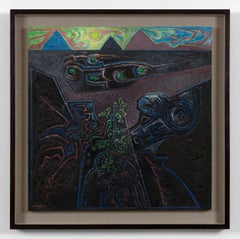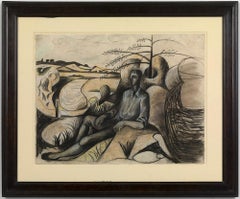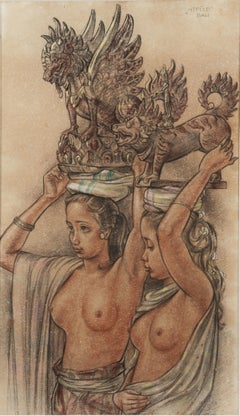John Craxton Art
3
3
2
2
1
1
Volcanic Landscape - 20th Century, Tempera on board by John Craxton
By John Craxton
Located in London, GB
Tempera and volcanic ash on board.
Signed lower left; also signed, titled and dated 1973 verso.
Category
1970s Modern John Craxton Art
Materials
Tempera, Board
Dancer in a Landscape - 20th Century, Work on paper by John Craxton
By John Craxton
Located in London, GB
Pencil, charcoal and conté crayon and gouache on paper
Provenance:
Christopher Hull Gallery
Private collection, UK 1992
Category
1940s Modern John Craxton Art
Materials
Paper, Charcoal, Crayon, Gouache, Pencil
Landscape (Spetses, Greece) - 20th Century, Mixed media on paper by John Craxton
By John Craxton
Located in London, GB
Mixed technique on paper. Dated lower left in ink: "10.10.46" and signed.
Category
1940s Modern John Craxton Art
Materials
Mixed Media
Related Items
Une Reunion
By Jean Tannous
Located in ATLANTA, GA
Born in Byblos lebanon, in 1946, is a contemporary plastician artist franco-canadian.
Artistic journey
Early days (1970-1975)
Paris (1976-2001)
Quebec (2002 - present)
China (2011-...
Category
21st Century and Contemporary Modern John Craxton Art
Materials
Mixed Media
Two Balinese Beauties (Mapeed), circa 1945
By Johan Rudolf Bonnet
Located in Amsterdam, NL
Rudolf Bonnet (1895-1978)
'Mepèèd' (Mapeed)
Signed lower right
Titled upper right
Pastel on gouache pigmented paper, 57 x 34 cm
In original carved ebo...
Category
1940s John Craxton Art
Materials
Paper, Crayon, Pastel, Gouache, Pencil
Free Shipping
H 22.45 in W 13.39 in D 0.04 in
PAESAGGIO - Tecnica mista su tela, firmato , 1970
Located in Napoli, IT
Dipinto Titolo"Paesaggio" realizzato tecnica mista su tela negli anni '70.
Category
1970s Modern John Craxton Art
Materials
Canvas, Mixed Media
Winter Landscape - Paint by Dumbra - Late 20th Century
Located in Roma, IT
Winter Landscape is an original contemporary artwork realized by the Artist Dumbra in the late 20th Century.
Relief material work (cementite and airbrush with glue).
Hand signed by...
Category
Late 20th Century Modern John Craxton Art
Materials
Mixed Media
H 19.69 in W 27.96 in D 0.79 in
The Carved Door, Semi-Abstract Tempera Landscape Painting with Flora and Fauna
By Archie Musick
Located in Denver, CO
Tempera on board painting titled 'The Carved Door' by Archie Musick, signed by the artist in the lower right corner. Depicts a semi-abstract landscape with flora and fauna. Presented...
Category
Mid-20th Century American Modern John Craxton Art
Materials
Board, Tempera
H 22 in W 11 in D 0.75 in
Pikes Peak, 1940s Colorado Mountain Landscape in Autumn, Tempera Painting
By Charles Ragland Bunnell
Located in Denver, CO
Original vintage 1941 Colorado landscape painting with autumn leaves and Pikes Peak blanketed in snow by Charles Bunnell (1897-1968). Inscribed verso, "To Laura, November 22, 1941", egg tempera on board. Signed by the artist in the lower left corner and titled verso. Presented in a custom frame, outer dimensions measure 15 ½ x 19 ¼ x 1 ¼ inches. Image size is 7 ¾ x 11 inches
About the Artist:
Artist and teacher, Charles ("Charlie") Bunnell worked in a variety of styles throughout his career because as an artist he believed, "I’ve got to paint a thousand different ways. I don’t paint any one way." At different times he did representational landscapes while concurrently involved with semi- or completely abstract imagery. He was one of a relatively small number of artists in Colorado successfully incorporating into their work the new trends emanating from New York and Europe after World War II. During his lifetime he generally did not attract a great deal of critical attention from museums, critics and academia. However, he personally experienced a highpoint in his career when Katherine Kuh, curator at the Art Institute of Chicago, personally chose one of his paintings - Why? - for its large exhibition of several hundred examples of abstract and surrealist art held in 1947-48, subsequently including it among the fifty pieces selected for a traveling show to ten other American museums.
An only child, Bunnell developed his love of art at a young age through frequent drawing and political cartooning. In high school he was interested in baseball and golf and also was the tennis champion for Westport High School in Kansas City. Following graduation, his father moved the family to Denver, Colorado, in 1916 for a better-paying bookkeeping job, before relocating the following year to Colorado Springs to work for local businessman, Edmond C. van Diest, President of the Western Public Service Company and the Colorado Concrete Company. Bunnell would spend almost all of his adult life in Colorado Springs.
In 1918 he enlisted in the United States Army, serving in the 62nd Infantry Regiment through the end of World War I. Returning home with a 10% disability, he joined the Zebulon Pike Post No. 1 of the Disabled American Veterans Association and in 1921 used the benefits from his disability to attend a class in commercial art design conducted under a government program in Colorado Springs. The following year he transferred to the Broadmoor Art Academy (founded in 1919) where he studied with William Potter and in 1923 with Birger Sandzén. Sandzén’s influence is reflected in Bunnell’s untitled Colorado landscape (1925) with a bright blue-rose palette.
For several years thereafter Bunnell worked independently until returning to the Broadmoor Art Academy to study in 1927-28 with Ernest Lawson, who previously taught at the Kansas City Art Institute where Bunnell himself later taught in the summers of 1929-1930 and in 1940-41. Lawson, a landscapist and colorist, was known for his early twentieth-century connection with "The Eight" in New York, a group of forward-looking painters including Robert Henri and John Sloan whose subject matter combined a modernist style with urban-based realism. Bunnell, who won first-place awards in Lawson’s landscapes classes at the Academy, was promoted to his assistant instructor for the figure classes in the 1928-29 winter term. Lawson, who painted in what New York critic James Huneker termed a "crushed jewel" technique, enjoyed additional recognition as a member of the Committee on Foreign Exhibits that helped organize the landmark New York Armory Exhibition in 1913 in which Lawson showed and which introduced European avant-garde art to the American public.
As noted in his 1964 interview for the Archives of American Art in Washington, DC, Bunnell learned the most about his teacher’s use of color by talking with him about it over Scotch as his assistant instructor. "Believe me," Bunnell later said, "[Ernie] knew color, one of the few Americans that did." His association with Lawson resulted in local scenes of Pikes Peak, Eleven Mile Canyon, the Gold Cycle Mine near Colorado City and other similar sites, employing built up pigments that allowed the surfaces of his canvases to shimmer with color and light. (Eleven Mile Canyon was shown in the annual juried show at the Carnegie Institute in Pittsburgh in 1928, an early recognition of his talent outside of Colorado.) At the same time, he animated his scenes of Colorado Springs locales by defining the image shapes with color and line as demonstrated in Contrasts (1929). Included in the Midwestern Artists’ Exhibition in Kansas City in 1929, it earned him the gold medal of the Kansas City Art Institute, auguring his career as a professional artist.
In the 1930s Bunnell used the oil, watercolor and lithography media to create a mini-genre of Colorado’s old mining towns and mills, subject matter spurned by many local artists at the time in favor of grand mountain scenery. In contrast to his earlier images, these newer ones - both daytime and nocturnal -- such as Blue Bird Mine essentially are form studies. The conical, square and rectangular shapes of the buildings and other structures are placed in the stark, undulating terrain of the mountains and valleys devoid of any vegetation or human presence. In the mid-1930s he also used the same approach in his monochromatic lithographs titled Evolution, Late Evening, K.C. (Kansas City) and The Mill, continuing it into the next decade with his oil painting, Pikes Peak (1942).
During the early 1930s he studied for a time with Boardman Robinson, director of the Broadmoor Art Academy and its successor institution, the Colorado Springs Fine Arts Center from 1930 to 1947. In 1934 Robinson gave him the mural commission under the Public Works of Art Project (PWAP) for West Junior High School in Colorado Springs, his first involvement in one of several New Deal art...
Category
1930s American Impressionist John Craxton Art
Materials
Egg Tempera, Board
H 15.5 in W 19.25 in D 1.25 in
Israeli Motke Blum Modernist Abstract Expressionist Oil Painting Bezalel Artist
By Motke Blum
Located in Surfside, FL
Motke Blum was born in Racacun, Romania in 1925. Early in his childhood, the Blum family moved to Bucharest where they settled in a house situated near a circus. The circus would become young Blum's greatest love. He befriended several of the clowns and other performers and, when not painting or playing in clay, Blum could be found enjoying the company of these spirited entertainers. These experiences would later become a recurring theme in many of his works of art.
In 1938, he was taken by the Romanian Iron Guard. When the Germans invaded Romania, Blum was taken to a forced labor camp. Even during his imprisonment, he continued to create art, painting on the walls of the camp. He escaped the Nazi camp in 1944 and boarded an immigrants' ship to Israel. One of the three ships in the convoy was sunk by a German torpedo. Motke later incorporated shipwrecks, boats, and other maritime subjects into several of his paintings.
Studies, Bezalel, Jerusalem, Enamel, Silversmithing, Painting and Sculpture.
1956 Seminar in the dep. of design in the royal silver factory of Zeist, The Netherlands.
Over the course of his long and fruitful career, Blum showed internationally at over fifty one-man-shows with exhibits in Israel, Holland, England, Belgium, the United States, France, Australia, and more. His art has been commissioned for public buildings and by prominent figures in Israel and around the world, and a series of posters were commissioned by the Justice Ministry and the Ministry of Tourism.
Group exhibition
Rina Gallery, Jerusalem
Artists: Motke Blum, Efraim Fima (Roytenberg, Ephraim) Zelig Segal, David Sharir, Joseph Halevi...
Category
20th Century Modern John Craxton Art
Materials
Mixed Media, Oil, Illustration Board
Israeli Modernist Abstract Expressionist Mixed Media Painting White on White
By Motke Blum
Located in Surfside, FL
In this artwork the artist uses the medium spontaneously .The paint has been smeared onto the surface, rather than being carefully applied. The resulting work emphasizes the physical...
Category
Mid-20th Century Modern John Craxton Art
Materials
Mixed Media
Mosque in Constantinople - Drawing - Mid-20th Century
By Gustavo Francalancia
Located in Roma, IT
Mosque in Constantinople is an original artwork realized in the mid-20th century, and attributed to Gustavo Francalancia.
Original mixed colored tempera and watercolor on plywood.
...
Category
Mid-20th Century Modern John Craxton Art
Materials
Tempera, Watercolor
H 27.56 in W 23.63 in D 0.04 in
Israeli Modernist Abstract Expressionist Gouache Painting Boats
By Motke Blum
Located in Surfside, FL
size is with frame.
Motke Blum was born in Racacun, Romania in 1925. Early in his childhood, the Blum family moved to Bukarest where they settled in a house situated near a circus. ...
Category
Mid-20th Century Modern John Craxton Art
Materials
Mixed Media
Landscape - Tempera - 1950
Located in Roma, IT
"Landscape" is an original painting in tempera and collage on cardboard, realized by Anonymous Artist of 20th Century.
In good conditions.
The artwork represents a summer landscape...
Category
1950s Modern John Craxton Art
Materials
Cardboard, Tempera
MB 804 A&B (Double Sided Figurative Drawing, Two Male Nudes and Safari Hunter)
By Mark Beard
Located in Hudson, NY
Figurative drawing with graphite, charcoal, and conte crayon on Arches paper
30 x 19 inches, unframed
One piece of 30 x 19 inch Arches paper. Two drawings on opposite sides.
These u...
Category
2010s Modern John Craxton Art
Materials
Charcoal, Archival Paper, Graphite, Watercolor
John Craxton art for sale on 1stDibs.
Find a wide variety of authentic John Craxton art available for sale on 1stDibs. You can also browse by medium to find art by John Craxton in paint, board, charcoal and more. Much of the original work by this artist or collective was created during the 20th century and is mostly associated with the modern style. Not every interior allows for large John Craxton art, so small editions measuring 19 inches across are available. Customers who are interested in this artist might also find the work of Modern British, Laurence Jones, and Mary Fedden.




